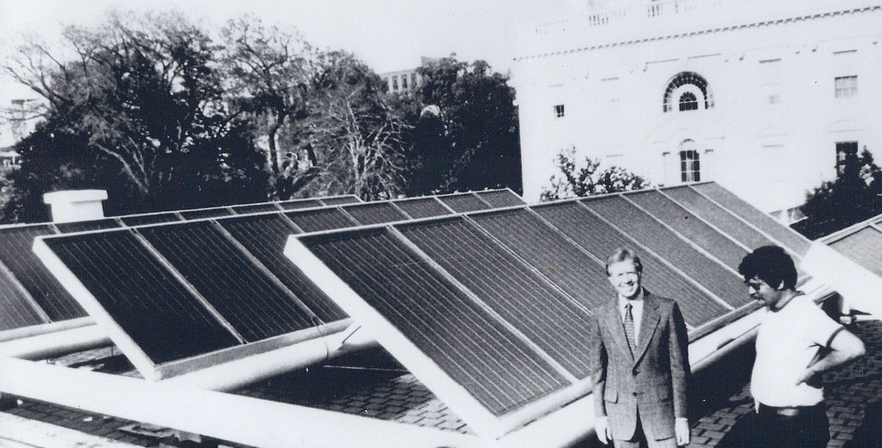In the first half of his essay, Dinning breaks down the concept of “sustainability” to critique its implications on the built environment and human ecology. In the associated video, from SCE’s Public Programs lecture series (only the first half is relevant to this essay), faculty member David White details his construction of a zero-energy affordable home, successfully addressing much of what Dinning discusses herein by approaching sustainability from a systemically integrated perspective. In the second half of the essay, to be presented in our first print edition, Dinning expounds upon this research with his own theory of ecological aesthetics.
T
he contemporary approach to sustainable development is inherently flawed, paradoxically preserving deleterious societal practices that perpetuate environmental damage.
As the adverse effects of climate change and resource scarcity escalate, the ineffectiveness of sustainable design strategies has become increasingly prevalent and demands alternative paradigms of environmental responsibility.
SUSTAINABILITY IN ARCHITECTURE
Architecture has addressed sustainability for millennia, yet the topic only recently entered mainstream discourse under growing threats of climate change and the depletion of natural resources. The term has been applied to numerous disciplines in a variety of applications, but is generally understood by the following definition: sustainable development “meets the needs of the present without compromising the ability of future generations to meet their own needs” 1. Energy conservation is of particular significance to architecture as buildings consume over a third of the world’s energy supply and 40% of all mined resources in their construction and operation 2. Architects have employed two primary strategies to reduce consumption. The first is bioclimatic, which embraces the natural conditions of the site, climate, and local context through passive design strategies in order to minimize buildings’ demand for external resources 3. This perspective also characterizes some architects’ appeal towards organic form. Complementing the bioclimatic approach is an anthropocentric promotion of active design strategies, which attempt to reduce consumption via efficient mechanical systems and regenerative energy sources 4. Combining these systems yields a discipline focused on the meticulous engineering of and reliance upon building systems to reduce the impact of buildings on environmental degradation and to preserve living standards for future generations.
INHERENT FLAWS OF SUSTAINABILITY
The intrinsic goal of behavioral preservation is unsound in both theory and pragmatics. It was consumption-driven society’s wasteful material processing and apathetic promotion of private wealth over communal welfare that caused (or amplified) current environmental crises. To advocate for sustaining these practices directly contradicts the goals of environmental conservation and revitalization, and exacerbates resource scarcity and climate change. Accordingly, the present needs of society will inevitably be unsustainable, invalidating the core premises of sustainability.
The current emphasis placed upon building performance and technological advancement intends to mitigate the exorbitant depletion of resources, yet it has had an adverse effect by acquitting people of their personal responsibility to uphold the environment, especially those who believe technology will be able to one day reverse climate change 5. While the majority of Americans believe the US needs to reduce its consumption of fossil fuels, they also take little personal responsibility for augmenting their own standards of living to lower their impact on climate change 6. Without the will to change habitual behavior, the underlying causes of environmental challenges cannot be addressed.
Furthermore, the notion of sustaining behavior without adapting to changing circumstances implies humans are able to overcome natural forces, and that Earth is merely a resource to support human existence. However, history has shown, conversely, that natural forces are dynamic and hospitable to changing lifeforms. Humans have become dominant over other species by continually adapting to environmental changes. Yet by trying to maintain the current state of society, humans are now resisting adaptation, or evolution, and thus threatening their own ability to survive.
INEFFECTIVENESS OF SUSTAINABILITY IN PRACTICE
The shortcomings of sustainability initiatives have calcified in their ubiquitously superficial applications. Numerous identifiable aesthetics of sustainability have developed and consequently become desirable for their semantic implications alone. For instance: solar panels, wind turbines, and green roofs publicly signify environmental consciousness, but are often installed in applications unsuitable to performance 7. Sustainability became a commodity, and “through its incorporation within the aesthetic economy… participates in the burgeoning cycle of consumption and waste that underlies the environmental crisis” 8.
The commodification of sustainable technologies has also contributed to the practice of absolving oneself from responsibility; one can more easily rationalize personal transgressions through the acquisition of individual components or gadgets that yield segmented, atomistic systems, what Howard Liddell calls “eco-bling” 9. President Carter foreshadowed “eco-bling” in a 1979 speech condemning Americans’ wasteful consumption:
“Human identity is no longer defined by what one does, but by what one owns. But we’ve discovered that owning things and consuming things does not satisfy our longing for meaning. We’ve learned that piling up material goods cannot fill the emptiness of lives which have no confidence or purpose.”
Even the agencies governing standards for the assessment of sustainable design promote “eco-bling.” The US Green Buildings Council’s Leadership in Energy & Environmental Design (LEED), for example, partitions sustainability into discrete components and rewards projects for each component added to their composition. Their ratings neglect function, context, and even the operational performance of buildings. Such subdivision of design places no value on holistic methodologies or architectural quality, and propagates buildings that have not been designed with concern for the experience of their users. In Germany – a country often praised for its ecological sensibilities – there has been a growing trend of dismantling high-performance houses that have been left vacant; the inhospitable structures of engineering have simply become “repositories to store materials” 10. The lack of adaptable durability is potentially the most damaging action architecture could have on the environment, as it requires the resource-intensive process of construction to occur more often.
REASSESSING THE PARADIGM FOR ENVIRONMENTAL CONSERVATION
Maintaining current practices is antithetical to enduring development. A more effective alternative to the contemporary paradigm would advocate for adapting our cultural practices and behaviors in response to changing environmental conditions. Shifting from sustainability to adaptability centers upon the dynamism of the human ecology, imparting a notion of personal accountability. The core tenets of reducing environmental degradation and resource depletion still apply, in addition to newer strategies that take advantage of natural conditions for more efficient performance.
Evidence shows that an appreciation for the consequences of climate change alone has little effect on influencing people’s behavior 11. Without feeling personally connected to such issues, people are reluctant to assume responsibility or take initiative in enacting change. However, given the interdependency of ecological and social networks, everyone is intimately involved. The key to promoting active engagement lies in cultivating self-awareness of individuals’ places within the greater context of these systems. This consciousness can be both introspective – bringing prophetic awareness of one’s own body, emotions, and physical sensations – as well as extroversive – informing oneself of one’s position in space, time, and societal structures. The primary concern of architecture should then be to understand how people sense and perceive their environment, which has historically been the domain of aesthetics.
THE AESTHETICS OF ENVIRONMENTAL CONSCIOUSNESS
Aesthetics, stemming from the Greek word aisthesis meaning “to perceive, feel, or sense,” 12 has been an essential and controversial subject in architectural discourse. It has incited debates on stylization, justified aberrant pedagogies of design, and been eschewed from the field altogether. The jurisdiction of aesthetics has also been called into question. Some believe aesthetics to be passive elements possessing beauty or virtue, but which are ultimately confined to the structure or object from which they pertain. Others, however, contend that aesthetics are active: they provoke responses and incite changes outside of their own beings. Understanding aesthetics not as appliqué or symbolism, but as subjective relays of environmental response, the definitive questions remain: Can aesthetics generate a consciousness of environmental systems and our symbiotic relationship to them?
Can aesthetics “reveal the ecological ground of human dwelling, or lead to new awareness of the rhythms and cycles necessary to sustain and regenerate life”? 13
JACK DINNING
NOTES
1 United Nations. “Report of the World Commission on Environment and Development: Our Common Future.” NGO Committee on Education, http://www.un-documents.net/our-common-future.pdf.
2 Straube, John. “Green Building and Sustainability.” Building Science Corporation (October 2006), http://www.buildingscience.com/documents/digests/bsd-005-green-building-and-sustainability/?searchterm=building%20and%20sustainability.
3 Olgyay, Victor. “Design with Climate.” In Aesthetics of Sustainability, by S. Lee, 69. Rotterdam: 010 Publishers.
4 Bothwell, Keith. “The Architecture of the Passively Tempered Environment.” In The Aesthetics of Sustainability, by S. Lee, 66. Rotterdam: 010 Publishers.
5 Patchen, Dr. Martin. . Public Attitudes and Behavior About Climate Change. Purdue Climate Change Resource Center. Purdue: Purdue University.
6 Kempton, Willett M., James S. Boster and Jennifer A. Hartley. “Environmental Values in American Culture.” Cambridge, MA: MIT Press.
7 Bothwell. “The Architecture of the Passively Tempered Environment.”
8 Hill, Glen. “The Aesthetics of Architectural Consumption.” In The Aesthetics of Sustainability by S. Lee, 38. Rotterdam: 010 Publishers.
9 Liddell, Howard. Eco-minimalism: the antidote to eco-bling. Riba Publishing, 2013.
10 Hill, Glen. “The Aesthetics of Architectural Consumption.” In The Aesthetics of Sustainability by S. Lee, 38. Rotterdam: 010 Publishers.
11 Patchen, Dr. Martin. . “Public Attitudes and Behavior About Climate Change.” Purdue Climate Change Resource Center. Purdue: Purdue University.http://www.merriam-webster.com/dictionary/aesthetic.
12 Merriam-Webster Dictionary. s. v. “aesthetics.” Retrieved 2014: http://www.merriam-webster.com/dictionary/aesthetic.
13 Skjonsberg, Matthew. “Magin, Inc. – Reframing the City.” In The Aesthetics of Sustainability by S. Lee: 229. Rotterdam: 010 Publishers.

